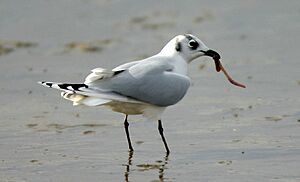Saunders's gull facts for kids
Quick facts for kids Saunders's gull |
|
|---|---|
 |
|
| Summer plumage | |
 |
|
| Winter plumage | |
| Conservation status | |
| Scientific classification | |
| Genus: |
Saundersilarus
|
| Species: |
saundersi
|
| Synonyms | |
|
|
The Saunders's gull (Saundersilarus saundersi) is also known as the Chinese black-headed gull. It is a type of gull that belongs to the Laridae family. You can find this bird in countries like China, Japan, North Korea, South Korea, Macau, Russia, Taiwan, and Vietnam.
These gulls naturally live in areas where rivers meet the sea, called estuarine waters. They also like marshy areas that are covered by water at high tide, known as intertidal marshes.
Like many other gulls, it was once thought to be part of the Larus group. But after studying its family tree, some experts moved it to the Chroicocephalus group. Others believe it is special enough to have its own group, called Saundersilarus. In 2023, the International Ornithologists' Union agreed with this change.
This gull is in danger because its habitat (the place where it lives) is shrinking. One of the most important places for them is the Yancheng Coastal Wetlands. About 20% of all Saunders's gulls in the world live there. The Saunders's gull is named after a British bird expert, Howard Saunders.
Contents
What Does Saunders's Gull Look Like?
This is a very small type of gull. It is only about 33 centimeters (13 inches) long. Among all gulls, only the little gull is smaller.
During the breeding season, adult gulls have a black head and the back of their neck is also black. Their body is mostly white, and their wings are a light grey color. They have a thin black band on their tail. Their legs and short beak are black, and their body looks a bit squat or chunky.
When they are not breeding, their black head becomes mottled grey. Their wings have white tips and black marks on the main flight feathers.
Where Do Saunders's Gulls Live?
Saunders's gulls breed in eastern China and along the west coast of Korea. They build their nests in saltmarshes. These marshes are mostly covered with a plant called seepweed (Suaeda glauca).
In winter, these gulls fly to warmer places. They spend the colder months in southern China, Hong Kong, Macau, Taiwan, South Korea, southwestern Japan, and Vietnam. Their winter homes include river mouths and ponds used for raising fish. Some groups even move inland to lakes and marshes.
How Do Saunders's Gulls Live?
Saunders's gulls are clever hunters. They fly about ten meters (yards) above the ground. When they spot something to eat, they quickly drop down to catch it. They mostly eat mudskippers, crabs, fish, and worms.
They also sometimes steal food from other birds. This is called kleptoparasitism. Saunders's gulls are not very good swimmers. Their feet are only partly webbed, so they usually stay on land. They move up the beach as the tide comes in.
Life Cycle and Reproduction
Saunders's gulls build their nests in saltmarshes. Their nest is a simple hollow in the ground. These birds are monogamous, meaning they stay with one partner. Each pair has its own territory.
The female usually lays two or three eggs in May. The parents take turns sitting on the eggs for about 22 days. This is called incubation. Both adult gulls and their young chicks leave for their winter homes in October.
Why Are Saunders's Gulls Vulnerable?
Experts believe there are about 21,000 to 22,000 Saunders's gulls left in the world. Sadly, their numbers seem to be going down. The IUCN (International Union for Conservation of Nature) has listed them as "vulnerable". This means they are at high risk of becoming extinct.
The biggest problem they face is that their habitat is being destroyed. They rely heavily on saltmarshes with seepweed plants. In many places like China, Taiwan, South Korea, and Japan, these saltmarshes are being drained. This is often done to create ponds for raising fish and other seafood.
Another issue is the introduction of a fast-growing plant called smooth cordgrass (Spartina alterniflora). This plant can take over the gulls' natural habitat. Also, if adult gulls are disturbed, their eggs and chicks are more likely to be eaten by predators.


